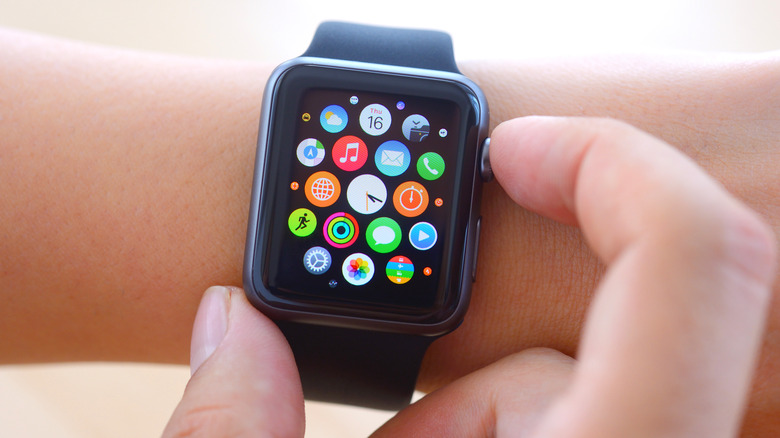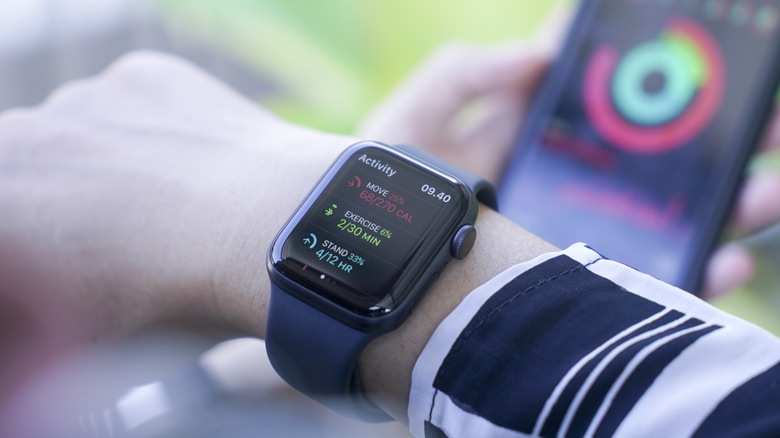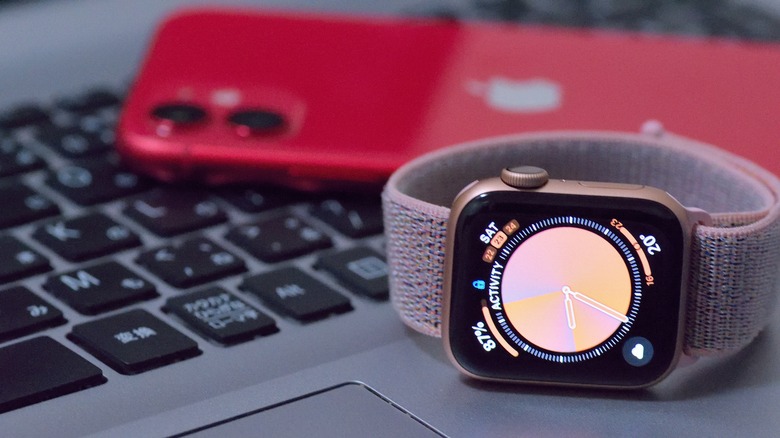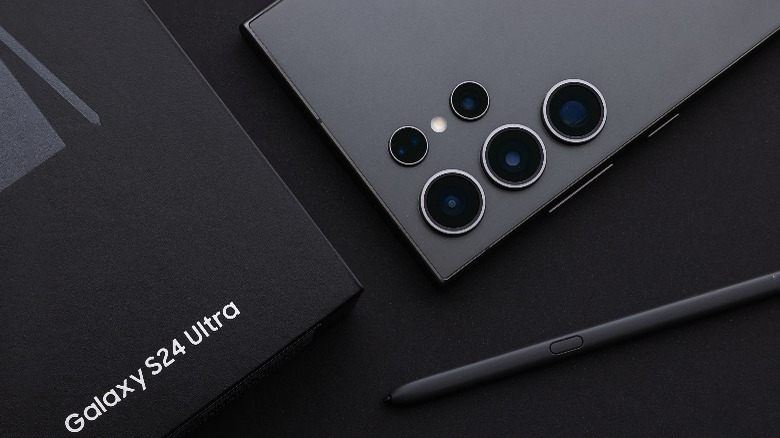

Can You Use An Apple Watch Without An iPhone?
source link: https://www.slashgear.com/1564660/using-apple-watch-without-iphone/
Go to the source link to view the article. You can view the picture content, updated content and better typesetting reading experience. If the link is broken, please click the button below to view the snapshot at that time.
Can You Use An Apple Watch Without An iPhone?

For some, the Apple Watch has been a game-changing technological advancement, placing the power of multiple devices and numerous apps squarely on their wrist. Yes, it's even a pretty good timekeeper, though the Apple Watch is arguably best loved for basically squeezing a fully functional iPhone into some serious wrist-sized swag.
The smart device does that by pairing directly with an iPhone via Bluetooth connection, which helps preserve battery life while allowing users to make or receive phone calls, send text messages, track personal fitness and health goals, and play games, among hundreds of other uses. However, given that the Apple Watch is at its operational best when paired with an iPhone, the question is how functional the device can be on rare occasions when you don't have your iPhone handy.
The good news is that your Apple Watch can be used as more than, you know, a watch when it's not connected to your iPhone. Here's what you need to know about using your Apple Watch without your iPhone.
Limited range of functions

We should tell you now that you will likely not have the full range of Apple Watch functions when the smart device is not connected to your iPhone. Despite that fact, you should still be able to play any music, podcasts, and audiobooks you've already downloaded to your Apple Watch, even if you don't have your iPhone. You'll also be able to record your thoughts using the note-taking apps of your choice or with the device's built-in voice memo app. You can also utilize most calendar functions and log any vital stats accrued during your latest workout, though you won't be able to share them.
Just FYI — the device also has a built-in GPS that can help you track speed and distances sans an assist from an iPhone. However, if your Apple Watch is capable of connecting to your cellular network, you'll have a few more functions available to you, including being able to make and receive phone calls and text messages. Over a cellular network, you'll also be able to use Apple Pay to make purchases in stores that support it as a form of payment. You can also use your Apple Watch to find other people and devices. You'll even be able to display pictures you've taken on your Apple Watch and view any photo albums you've synced through your Apple account.
Apple Watch functions when connected to Wi-Fi

If you somehow find yourself without an iPhone or a cellular network connection, you'll be happy to know the Apple Watch adorning your wrist can likely still be used as more than a watch. You will, however, need to be in the range of a suitable Wi-Fi network to make use of your Apple Watch.
If you are connected to a Wi-Fi network, you can use an Apple Watch for phone calls and FaceTime audio calls, as well as send and receive text messages. You can also connect to the App Store over Wi-Fi, meaning you can buy and download all the health-tracking apps your little heart desires. A Wi-Fi connection even grants Apple Watch access to iMusic, meaning you can add whatever music, podcasts, and audiobooks you're listening to. Yes, you'll even be able to stream them on the streaming service of your choice.
Connecting to Wi-Fi will also allow Apple Watch owners to run more run-of-the-mill apps, like those used to track local weather and stocks. More importantly, Apple Watch users should be able to access any apps and devices currently used to control a smart home. So, even if you don't have your iPhone, your Apple Watch can still be an invaluable piece of personal technology.
The 5 Best And 5 Worst Samsung Phones Of All Time

Samsung may not have ever built up the same cultural cache that Apple has, but that hasn't stopped the company from become something of a titan — especially in the world of Android devices.
As a leader in smartphone innovation, Samsung has delivered some highly memorable devices over the years. It has given us some highly forgettable ones, too, and the company has also had its share of occasionally embarrassing moments. From impressive flip phones and folding devices to worldwide recalls, it has been a rollercoaster ride for the Korean company.
With AI innovations and game-changing cameras, the latest releases by both Apple and Samsung make the future look like a two-horse race. Still, it took a past littered with hits and misses for Samsung to get where it presently is, and that's what we will take a look at today. In no particular order, here are five of the best and five of the worst Samsung phones we have been treated to over the years.
Best: Samsung Galaxy S II
The Samsung Galaxy S II was the blockbuster sequel to the Galaxy S and was, quite simply, a runaway success. Launched in 2011, it helped position Samsung as a major player in the Android market and was among the first of its kind to seriously threaten iPhone dominance. While it was far from perfect — especially when compared to some beasts of today — the Galaxy S II packed in a lot of the best available hardware of the time. It featured a 1.2GHz dual-core Exynos processor and a stunning Super AMOLED Plus display that served as its standout feature. It also pushed performance levels of the time with its 1 GB of RAM.
Additionally, owners got cutting-edge full HD video and an 8MP main camera that produced sharper and more vibrant images than what was generally on offer back then. Furthermore, the battery delivered more than 18 hours of continuous use on a 2G network. Yet somehow, Samsung managed to keep the phone relatively slim and lightweight. Other features that became more commonplace after appearing on the S II included mobile hotspot tethering, near-field communication, and a selfie camera for taking "vanity shots," as we described them in our 2012 Samsung Galaxy S II review.
All in all, the Samsung Galaxy S II was significant in the tech giant's journey to prominence and is considered by many today to be the best Samsung phone of all time.
Worst: Samsung Galaxy Note 7
The Galaxy Note 7 actually a terrible phone, it's just that it had a tendency to spontaneously combust. If you could sleep well knowing that, you'd have had yourself a pretty decent phone. However, you couldn't take it very far as it was banned from going on flights, and there was eventually a worldwide recall.
However, pros and cons lists around the web noted its superb display, quality build, excellent camera, and long battery life against its premium price, mono audio, and the fact that it might explode in your pocket at any given moment. We gave the Galaxy Note 7 a positive review back in 2016, but that was before reports of the defective battery arrived — the fact is that this phone should never have seen the light of day.
To this day, the Note 7 battery fiasco remains the most noteworthy blight in smartphone history and seriously damaged Samsung's reputation around the world. Thankfully, the company learned from its mistakes and has delivered a number of high-quality smartphones since that haven't threatened the lives of anybody whatsoever.
Best: Samsung Galaxy S24 Ultra
While its AI innovations haven't impressed everybody, Samsung has undoubtedly integrated some fantastic features into the S24 Ultra that make it stand head and shoulders above the competition – at least in relation to its Android cousins.
Overall performance has been taken up a considerable notch on the S23 Ultra by utilizing a snappy third generation Snapdragon 8 processor, which, together with the phone's 12GB of RAM, ensures buyers are getting one of the fastest and highest-performing phones of all time. With a genuinely durable build – the Gorilla Armor glass is exclusive to the S24 Ultra – and seriously impressive peak brightness, there is little to dislike about this phone.
Of course, it's the Galaxy AI features that has got people buzzing. The most innovative is the Live Translate feature, which can translate voice calls or even face-to-face conversations in real-time. While the technology isn't quite at the level of a sci-fi universal translator, it is an impressive addition. However, we found that the S23 Ultra's Chat Assist feature, while useful most of the time, tends to throw up some amusing results, especially with its emoji and hashtag suggestions. The S24 range also saw the debut of the Circle to Search feature, which allows you to simply circle a picture to get instant Google results.
The camera also takes things to a new level. The 200MP primary lens is complemented by a 50MP 5x zoom telephoto and artificial intelligence gets in on the action here, too, with AI Zoom. This allows photographers to get sharp details, with surprisingly good results – even when zooming in as far as 100x.
Worst: Samsung Galaxy S4
Design-wise, the Galaxy S4 was essentially the Galaxy S3 with a fresh lick of paint. However, this didn't stop people from buying it, and the phone was still something of a bestseller. Yet, its plastic build, average camera quality, and disappointing battery life led to some poor reviews and pressure on Samsung to be more innovative.
However, it was the TouchWiz skin and its many unnecessary features that ruffled most feathers. With gimmicks like head-tilt scrolling never gaining traction and other "innovative" features like Group Play, with its ability to sync the phone into a surround sound system with other phones, the S4 was criticized for its abundant bloatware. Many users felt it led to performance issues and a cluttered all-around experience.
In our 2013 review of the Galaxy S4, we mentioned that Samsung didn't put enough expertise into the camera. We noted that raising its pixel count didn't quite allow the phone to compete with its closest competitors, and images in low light often returned noisy, poor quality results. The absence of an optical image stabilizer would have been partly responsible for this, but we also noted that the camera often had a difficult time focussing on close-up subjects.
With hindsight, the S4 should have broken new ground instead of retreading much of the same. Perhaps Samsung needed to prioritize genuine innovation instead of flashy gimmicks. Nevertheless, the unit's strong sales surely spurred the company into allocating more resources to future breakthroughs.
Best: Samsung Galaxy Nexus
The Super AMOLED technology on the Samsung Galaxy Nexus contributed to the phone delivering one of the richest and best-detailed displays at that time. It was one of the first to sport a 720p HD screen, and it was also a large one at 4.65 inches. The phone felt robust and featured a metal inner frame that made it that bit more durable than its competitors, and it was also impressively lightweight and thin.
However, as we noted in our 2012 review of the Samsung Galaxy Nexus, it was the company's close collaboration with Google that propelled the Samsung Galaxy Nexus to the upper echelons of smartphone history. This eliminated Samsung phones' most prominent problem of the time — the TouchWiz user interface — allowing the Galaxy Nexus to run on stock Android without pesky Samsung modifications. Users got a much more satisfying experience with quicker updates and an altogether more user-friendly interface.
They also enjoyed the many other perks that the Android Ice Cream Sandwich OS had to offer, including enhanced multitasking, resizable widgets, photo improvements, and face unlock. It was also one of the first phones to come fitted with the NFC chip, which has become increasingly commonplace in smartphones.
However, sales were on the modest side. Yet the Galaxy Nexus played a significant role in Android evolution and remains a notable entry in the history of smartphone releases.
Worst: Samsung Galaxy S6
With the Galaxy S6, Samsung prioritized aesthetics and build over everything else. So while it did have a luxurious metal and glass design, the company also championed a rather steep and unjustified price hike. However, Samsung was eventually pressured to slash prices on both the Galaxy S6 and the Galaxy S6 Edge after disappointing sales.
Still, it was the phone's exclusions rather than the price that garnered the most criticism in our review of the Galaxy S6 from 2015. One of the more controversial omissions was the Micro SD card slot, which meant Samsung supporters could no longer expand their phone's storage. Furthermore, the battery was sealed in. This was particularly disappointing because the S6 also had a reduced battery life compared to the S5, and users could no longer swap out for a spare. The lack of an IP rating also dismayed many loyal Samsung fans as Apple continued to dominate the market.
It wasn't all doom and gloom, however. The S6 featured a top-tier 16MP camera with optical image stabilization. In addition, performance was snappy, and users could enjoy fast wireless charging. It also featured a vibrant and sharp HD AMOLED display that drew particular praise. Despite those features, many felt the Galaxy S6 was a significant step down from the water-resistant, Micro SD card equipped Galaxy S5 with its removable battery.
Best: Samsung Galaxy Z Flip 5
Returning to more recent times, the Samsung Galaxy Z Flip 5 succeeded the Z Flip 4 in the late summer of '23 and managed to improve on what was a particularly popular Samsung flip phone. With a speedy Snapdragon 8 Gen 2 chipset and 8GB of RAM, the Z Flip 5 improved on performance.
Additionally, the stunning Foldable Dynamic AMOLED 2X display maintained its large dimensions and 120Hz refresh rate but increased the peak brightness to an impressive 1,750 nits. This meant that the stunning display still featured smooth scrolling, and you could easily see it in bright conditions, including under intense sunlight. You also got the same useful outer screen that was so loved on the Flip 4.
So, the Flip 5 looked better than ever, which was impressive enough in itself. However, We noted in our review of the Galaxy Z Flip 5 that Samsung also managed to fix the overall design problem of the Flip 4 by eliminating the gap that was evident when you folded the phone shut. With the design now perfect, the phone was even thinner and could slip into the tightest of pockets with ease.
Complemented by its excellent selfie camera, it proved to be a big hit among the fashion-conscious. The omission of a telephoto option may have dissuaded the more serious smartphone photographer, but this phone was all about looking dapper, and it succeeded in doing just that.
Worst: Samsung Wave S8500
Samsung's proprietary bada OS was the primary reason for this absolute failure back in 2010. While the Wave S8500 did receive praise from some quarters for its hardware, it was the software that let it down and was universally panned. We tried our best to give the Samsung Wave S8500 an honest and balanced review, admiring the thin, robust build, the sharp, bright Super AMOLED display, and other features that made the phone so promising. However, it was impossible not to take not of the fact that the device was hampered by its poor operating system.
While Samsung aimed to provide a compelling user experience for smartphone users, there were several complaints. Chief among them was a lack of available apps. Samsung Apps, which was where you had to source them for the Wave S8500, had fewer than 1,000 available at that time, compared to the 200,000 available on the Apple App Store. As a result, there really didn't seem much point in investing in the Samsung Wave S8500. Even the Google Play Store had 70,000 titles at the time — but these were only compatible with other Samsung phones.
However, the whole bada affair wasn't a complete waste of time. It was a valuable addition to Samsung's experience in technology development and went a long way to priming future innovations.
Best: Samsung Galaxy Note
The Samsung Galaxy Note was a momentous release in the company's history that unleashed the stylus equipped phablet to the world. It paved the way for larger displays to become commonplace and introduced the game-changing S-Pen. This large screen and accurate, pressure-sensitive stylus combination ensured the Galaxy Note was the first smartphone designed for serious productivity.
At that time, phone manufacturers were obsessed with making their devices as compact as possible. That was, after all, the idea behind a mobile phone, but the Galaxy Note changed all that. While the original Note had a somewhat smaller display than some of the behemoths we see today, at that time 5.3 inches was enormous.
Thus, the phablet was born. It set the stage for an abundance of smartphones with large displays, which shows no signs of slowing down today. However, the Samsung Galaxy Note was still portable despite its large display. Its extra-thin build meant it could still be slipped into a front pocket with ease.
Sales were relatively modest, but the target market was still niche. The reception the original Note received was somewhat polarizing, but boy, did it and many of its successors go on to prove everyone wrong.
Worst: Samsung Galaxy Fold
While the Galaxy Fold series has gone on to some profound innovations in the folding phone field, the original model didn't exactly lay a great foundation for success.
Compared with the outstanding feats of engineering evident in the latest Fold and Flip models, the original Samsung Galaxy Fold didn't have the robust design needed to bode well for the future. It was very flimsy, to begin with, and there was even a release delay as many of the units that were sent out to publications to review were breaking. The situation improved somewhat upon launch, but many reviewers and consumers of the time were still not convinced by the phone's durability.
While it did look very cool, worked like a foldable tablet, had a powerful battery, and took phone gaming to a new level, it was outrageously expensive. In fact, it was around double the price of other flagship phones at that time. Considering the fragile plastic screen, it has to go down as one of Samsung's biggest disappointments. Thankfully, durability and design improved in the subsequent iterations, and recent iterations such as the Galaxy Z Fold 5 are now more akin to the vision Samsung must have initially had.
How we arrived at our choices
It took a lot of work to whittle down the list of outstanding Samsung phones to just five, and finding five that could be considered bad phones — with one or two exceptions — was even more of a challenge.
However, after considering our expert SlashGear reviews, we also looked at historical consumer reviews alongside total units sold. Finally, we looked at major incidents and important innovations that Samsung phones have given us over the years, all while taking into account how those shaped important industry trends — for better or for worse. This led us to our final set of the five best and the five worst Samsung phones of all time.
Recommend
About Joyk
Aggregate valuable and interesting links.
Joyk means Joy of geeK